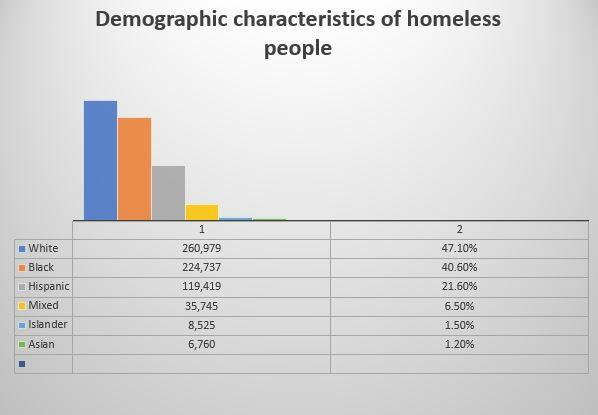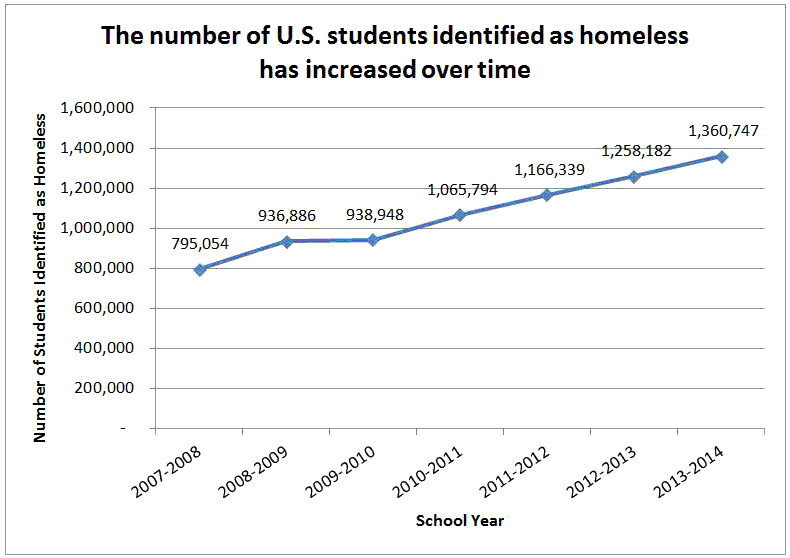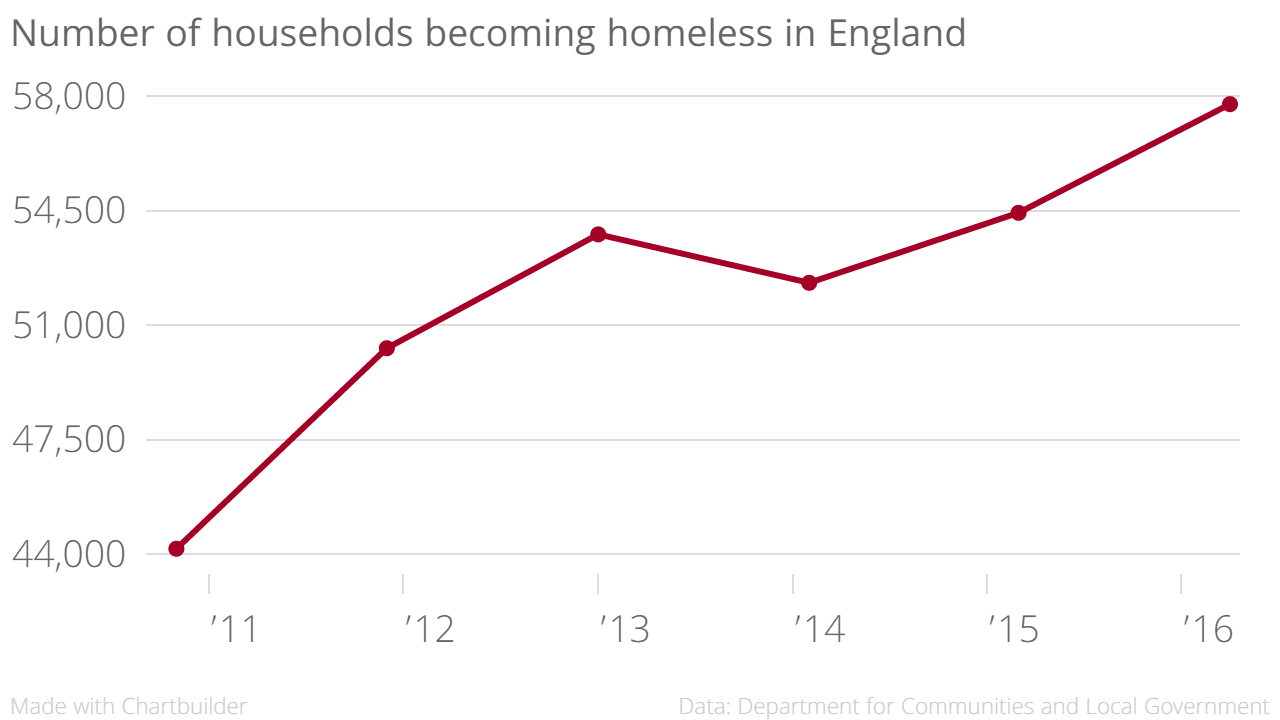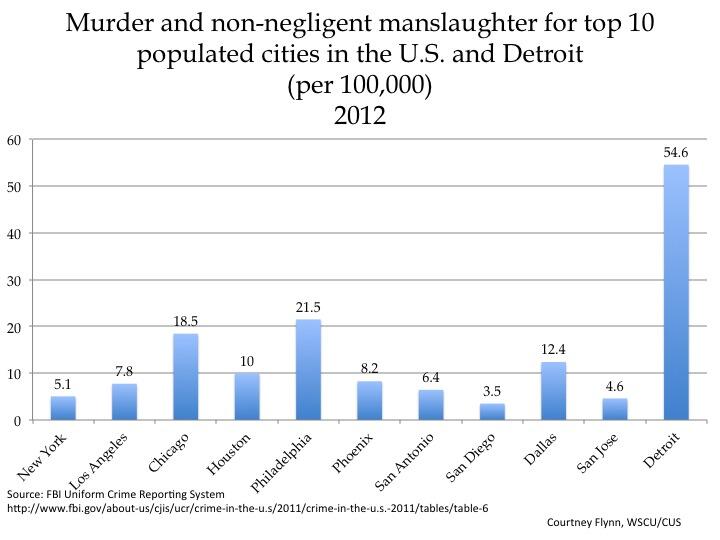Social Issue of Interest
Homelessness is one of the major concerns in the United States over the past several decades. As urbanization continues to gain popularity in the country, housing facilities in major towns have become less adequate. According to Henwood et al. (2015), homelessness refers to a situation where an individual lacks a primary residence within a given location. Such individuals are forced to sleep in makeshift tents and other premises that do not qualify as homes.
State and federal governments have enacted policies to help fight this problem but unfortunately, homelessness continues to persist. As the cost of rental facilities increases in major towns, the number of those who cannot afford to pay for these facilities is increasing. Unfortunately, most of the local, state and federal policies have failed to provide a lasting solution to this problem. In this paper, the researcher seeks to explain the cause of the problem, its implications, and the effort that different stakeholders are taking to address the problem.
Questions Guiding the Examination of the Issue
The United States is the largest economy in the world, with high living standards. It is unfortunate that in such a country of rich resources, numerous people cannot afford basic accommodation. Stakeholders need to find a way of addressing this problem. This study identifies factors that make the problem worse. The following are the specific questions that will guide this study as it seeks to find ways of addressing the problem:
- What are the main factors contributing to the problem of homelessness in the United States?
- Which population is worst affected by the problem of homelessness?
- Which policies have been developed by various authorities to address the problem?
- How effective have these policies been in addressing the problem?
- What are the alternative ways that stakeholders can use to have a lasting solution to the problem?
Population Groups and Individuals at High Risk of Becoming Homeless
The problem of homelessness affects people of different races, religions, academic backgrounds, ages, and many other factors. However, Alowaimer (2018) notes that a section of society is more affected than the rest of the population. The African American population is the worst affected group in terms of race. The systematic injustices that they have faced in the country for over a century put them at a disadvantage in terms of financial empowerment.
Although the problem of racism is not as bad as it was in the past, African Americans are less likely to get high-paying jobs compared with whites who have similar qualifications (Morton et al., 2018). Students in institutions of higher learning constitute another high-risk group when it comes to the problem of homelessness in the country. A significant number of students cannot afford to pay for hostels close to their learning institutions. Drug addicts and those who are engaged in low-paying jobs also form another vulnerable group.
Factors That Make the Group at High Risk Compared with Other Groups
African Americans, students, and drug addicts have been identified as the most vulnerable groups to the problem of homelessness. African Americans are vulnerable to this problem because they are still at a disadvantage in the country when it comes to getting good employment. Despite their academic qualifications, the majority of employers still prefer hiring whites to blacks, which means that they are more vulnerable to becoming homeless.
Auerswald and Adams (2018) also note that some property owners often prefer renting out their units to whites because of the wrong perception that blacks are often violent and are less likely to default on paying their rental fees at the right time. Students are at risk of becoming homeless because, in most cases, they have to move away from their homes to college. When the rental fee for the hostels is high, they may be forced to share rooms with their colleagues.
Others are forced to live in cars for lack of better alternatives. Drug addicts are also vulnerable to becoming homeless. The problem is that most of these people spend a significant amount of their earnings on drugs. Once they take these drugs, they are unable to engage in any meaningful economic activity (Henwood et al., 2015). In a society where one has to pay for every service one gets, these addicts are unable to afford to pay rent.
Factors Contributing to the Situation
Homelessness is a socio-economic problem in the United States. As a country that has fully embraced capitalism, the ability of an individual to have access to basic needs depends on how effective they are in generating revenues. The government has social welfare programs meant to subsidize rental fees for those who are financially challenged. Different states also have housing programs where those who are homeless are offered places to stay at the cost of the government.
The problem is that what the government offers is not enough. The increased immigration is another factor contributing to the problem of homelessness in the country. According to Alowaimer (2018), the majority of those coming to the United States are economic immigrants. They mainly come to major urban centers where they believe they can find good employment. A good population of these immigrants is often rendered homeless soon after settling in these cities.
Statistics Demonstrating the Escalation of the Situation
It is important to review statistics that demonstrate the escalation of the problem of homelessness among a section of society. Figure 1 below shows the number of those who are homeless in the United States in 2016. A huge number of whites, estimated to be 260,979 people or 47.10% of the total population of those who are homeless are affected by the problem. Unlike the popular opinion that the problem of homelessness only affects blacks, statistics show that there are more white homeless Americans than there are blacks.
The statistics show that 224,737 blacks are homeless, which represents about 40.60% of all the homeless Americans. Given the total population of blacks in the United States, it means that the problem affects more blacks than whites. About 119,419 Hispanics in the United States are homeless, representing about 21.60% of the population of homeless Americans. Islanders and Asians form the minority of those who are homeless in the country.

The government should give special attention to the problem of homelessness among American students. As shown in figure 2 below, it is evident that the number of learners who cannot afford to pay for accommodation in hostels around their learning institutions is consistently increasing. In the academic year 2007/2008, there were about 795,054 college students without permanent places of residence across the country.
The number has since almost doubled. In the academic year 2013/2014, the number had increased to about 1,360,747 learners. It is important to note that these learners rarely consider themselves homeless because some can share hostels with their friends. It explains why the overall population of homeless Americans is smaller than the number of students without permanent residence close to their learning institutions.

Reasons for Escalation of Homelessness
The escalating problem of homelessness is a major concern to policymakers and other stakeholders in the country. According to Morton et al. (2018), one of the main reasons that led to the escalation of the problem is the collapse of the subprime mortgages that proceeded with the 2008 global economic recession. As homeowners became less capable of paying the increased cost of their mortgages, they were evicted, rendering them homeless. Since then, many financial institutions are unwilling to offer mortgages to individuals who lack solid financial background. As such, a lesser number of people can afford to own homes in the United States.
The increasing number of economic migrants is another source of the problem. The majority of those who come to the country have no one that they can stay with, especially in the initial years when they are yet to get good employment. In major cities such as New York where the rental fees are significantly high, these people are often forced to stay in makeshift structures in the country.
Alowaimer (2018) explains that underemployment is another issue that should not be ignored when trying to address the problem. In some of the cities in the country, a two-bedroom apartment costs more than two thousand dollars a month. The problem is that some of the low-paid workers in the country cannot afford such high fees as rent. These people are working daily, but they are forced to share homes or even sleep in their cars to meet the high cost of living in the country.
Henwood et al. (2015) note that some employers are paying their worker’s bare minimum salaries. In some cases, these employers pay workers salaries below the minimum wage set by the government, especially when they know that they are dealing with illegal immigrants. Such low salaries cannot allow these individuals to pay high rental rates.
How Homelessness in the United States Compare with Other Countries
The problem of homelessness is not unique to the United States. According to Henwood et al. (2015), the problem is common in both developed and developing countries around the world. As many people move to major urban centers, housing facilities are getting strained. In the developed countries, the problem is different from what it is in developing countries. Auerswald and Adams (2018) observe that in some European cities such as London, the rich are purchasing homes for speculative purposes.
It is common to find cases where an apartment that housed over 50 families is renovated to be used by one financially empowered family. The rich are forcing the working class out of Landon and many other economic hubs in parts of Europe. As shown in figure 3 below, the number of homeless people has been increasing consistently from 2011 to 2016 in England. The trend where the rich are converting large apartments into large homes is partly to blame for the problem. If measures are not taken to address the problem, it would get worse in the coming years.

Germany is another country facing a similar problem. In major cities such as Munich and Berlin, the rental cost has been going up over the past decade (Morton et al., 2018). Those who can afford such high costs are decreasing, which is a major concern. The cost of a mortgage is also high, which means that the number of homeowners in these cities is low. The immigration crisis following the aftermath of the Arab Spring has worsened the problem of homelessness in the country. The majority of these migrants are moving to major urban centers to look for employment, putting further strain on housing facilities in these institutions. The government may need to develop policies that can help address this concern.
Data on the Social and Economic Cost of Homelessness
Homelessness is a major socio-economic problem that is proving costly in the country. Detroit is one of the cities in the United States worst affected by the problem of homelessness. As shown in figure 4 below, it also has one of the worst cases of murder, non-negligent manslaughter, and other crimes in the country. Philadelphia, Dallas, New York, Chicago, and Los Angeles are the other cities where homelessness is becoming a major problem in the country.
The figure below shows that they are also some of the worst affected cities in terms of violent crimes. Such criminal activities are costly to the states in terms of the investigations that have to be conducted to arrest and prosecute the criminals. Holding these criminals is also a costly undertaking. Cases of break-ins are common in cities where the number of homeless people is high. Such burglaries often affect hard-working Americans.

How the Society Has been Dealing with the Problem through Various Policies
The United States has been committed to addressing the problem of homelessness at federal, state, and county levels for the past several decades. It is important to note that there has been valuing conflict in terms of the perception of homelessness. Although its definition is clear to members of society, the best approach to solving it is still not clear. According to Auerswald and Adams (2018), states have formulated policies and administrative rules meant to reduce the number of homeless people across the country.
One such state with clear policies of dealing with the problem in California. Homeless Youth Multifamily Housing Program, Veterans Housing and Homelessness Prevention Program, Supportive Housing Multifamily Housing Program, and Emergency Solutions Grant Program are some of the popular policies in the country (Morton et al., 2018). The purpose of these policies is to support those who are unable to meet the cost of renting their facilities because of various challenges.
The government has funding programs to help in the implementation of most of these policies meant to reduce homelessness. Some of the additional funding comes from the federal government (Samudra & Yousey, 2018). The political class in the state who are keen on addressing the problem proposed most of these policies. It is not clear whether there were hidden agenda when formulating these policies other than the need to solve the problem of homelessness in the state.
Because of these policies, veterans in the state have access to houses with subsidized rents. Others who are financially challenged are offered accommodations fully funded by the government. The programs have been effective in terms of reducing the number of homeless individuals in the streets. However, it is important to note that the problem persists.
The strength of these programs is that they focus on providing direct support to the affected population. It has helped many families who cannot afford to rent out these facilities. However, Alowaimer (2018) notes that the main weakness of these policies is that they encourage people to seek government support even when they can pay for their apartments. The main recipients under this program should be the financially challenged members of society. However, some of those benefiting from the program have gainful employment. The government of California, through various relevant authorities, has the responsibility of overseeing the program.
Changes That Have Worsened the Situation
It is important to appreciate that there have been changes, which have worsened the problem of homelessness. One of the changes witnessed over the years is increased migration into the country. According to Auerswald and Adams (2018), the United States remains the most preferred destination for migrants around the world. Most of these people are looking for better employment opportunities, which means that they are financially challenged.
They are the worst affected group when it comes to the problem of underemployment. They get salaries that cannot support their basic needs. Most of them resort to sharing houses as a way of sharing the high cost. Others are forced to convert their cars into houses as a way of meeting the cost of basic needs.
Alowaimer (2018) argues that the consistent increase in the cost of rent is another change that has worsened the problem. The rental cost in major cities in the United States has been on the rise over the past decade. The problem is that their income has not been increasing at the same rate. Many people who could afford to pay for these houses are forced to look for cheaper alternatives. Auerswald and Adams (2018) also note that changing regimes at federal, state, country, and local levels is another problem. When a new regime comes to power, it is not guaranteed that it will continue implementing policies of the previous regime. As such, the political class rarely meets its promise of addressing the problem of homelessness in the country.
Implications of Homelessness if it is Ignored
The United States cannot afford to ignore the problem of homelessness in the country. According to Auerswald and Adams (2018), the implication of homelessness, if ignored for long, maybe devastating. In Florida, it is common to see makeshift structures along major streets that homeless people use. The case is not unique to this city as New York, Los Angeles, and Dallas are also experiencing the problem. These major global towns are slowly transforming into slums.
If it is not controlled, security will become a major challenge in these cities. These homeless individuals can easily commit crimes such as burglary or even murder in neighborhoods where they set up their makeshift homes. Authorities cannot easily trace them down once they commit such crimes, which is a major concern in the country. Compromised security means that tourists will consider visiting other parts of the world where they are sure they cannot be attacked.
Economic activities in these towns will also be affected. Many businesses prefer operating in places where their security is assured. Cities with a large number of homeless people may become less attractive to investors. It is also important to understand the fact that the problem also affects the homeless. Sleeping in the streets exposes them to the threat of physical attack. They are more susceptible to various health problems, especially during cold winters. The government will end up spending more resources to offer them the medical services they need. It is more costly to the government and citizens of the United States to have a high number of people who are homeless. As such, all stakeholders must work as a unit to solve the problem.
Summary
Homelessness is one of the biggest socio-economic problems in the United States. The federal, state and county governments have invested resources and time to resolve this problem. Non-governmental institutions have also been keen on helping those who cannot afford to pay their rent. However, the problem persists. The study shows that increasing immigration, underemployment, and consistent increase in rental fees are to blame for the increasing number of homeless Americans.
The government cannot afford to ignore this problem because of the implications that it has. Insecurity is one of the main concerns that are associated with homelessness. The study shows that developing effective policies and the goodwill to implement them can help reduce the prevalence of homelessness in the United States.
References
Alowaimer, O. (2018). Causes, effects and issues of homeless people. Journal of Socialomics, 7(3), 1-4.
Auerswald, C. L., & Adams, S. (2018). Counting all homeless youth today so we may no longer need to tomorrow. Journal of Adolescent Health, 62(7), 1-2.
Henwood, B. F., Wenzel, S. L., Mangano, P. F., Hombs, M. E., Padgett, D. K., Byrne, T. … Rice, E. (2015). The grand challenge of ending homelessness. American Academy of Social Work and Social Welfare, 1(9), 1-22.
Larkin, H., Aykanian, A., & Streeter, C. L. (2019). Homelessness prevention and intervention in social work: Policies, programs, and practices. Cham, Switzerland: Springer.
Morton, M. H., Dworsky, A., Matjasko, J. L., Curry, S. R., Schlueter, D., Chávez, R., … Farrell, A. F. (2018). Prevalence and correlates of youth homelessness in the United States. Journal of Adolescent Health, 62(1), 14-21.
Padgett, D., Henwood, B. F., & Tsemberis, S. J. (2016). Housing first: Ending homelessness, transforming systems, and changing lives. New York, NY: Oxford University Press.
Samudra, R., & Yousey, A. (2018). Defining homelessness in the rural United States. Online Journal of Rural Research & Policy, 13(4), 1-27.